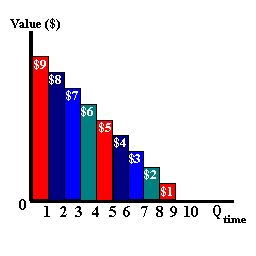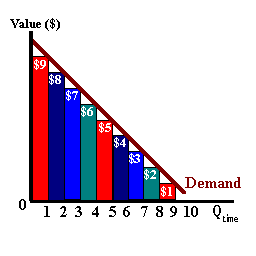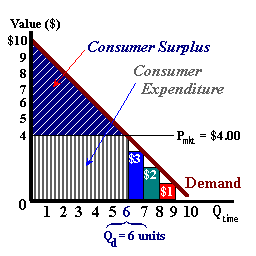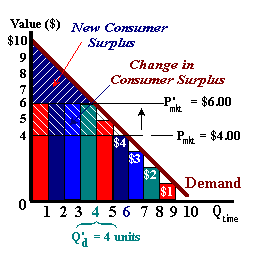 |
 |
When analyzing changes to a consumer optimum resulting from changes in the market price of a particular commodity, we often speak of the consumer being better or worse off. What is missing in this analysis is the ability to quantify changes in individual satisfaction due to these price changes.
One method used to measure these welfare changes is through the use of a concept known as Consumer Surplus. This method compares the value of each unit of a commodity consumed against the price of that commodity. Stated differently,
consumer surplus measures the difference between what is person is willing to pay for a commodity and the amount he/she actually is required to pay.
Individual consumer demand is a measure of willingness to pay. As shown in the diagram below, consumers often value each additional unit acquired less that previous units (i.e., the concept of diminishing marginal utility).
For example, suppose that the good in question is monthly consumption of gasoline. Based on the data in the diagram below (left), the consumer would be willing to pay $9 for the first gallon rather than go without. This first gallon would be used for essential driving activities. Each successive gallon has a value to the consumer of $1 less than previous units (2nd gal = $8.00, 3rd gal. = $7.00, and so on) as needs are met and the consumer engages in driving more for pleasure and sight-seeing. The value that the consumer places on each gallon (unit) consumed is summarized by the individual Demand curve as shown in the diagram on the right.
 |
 |
Consumers do have a choice in the purchase of gasoline or other goods. Either they could avoid market participation and spend nothing and receive nothing of value or they can purchase a certain quantity of this good and receive value over-and-above the market price. Consumer surplus represents the incentive or reward to consumers for participating in the market place.
If the market price of gasoline were $4.00 (for each and every gallon -- the seller not being able to determine the value of each gallon sold), the consumer would buy 6 gallons per month (see figure 2 below left).
 |
 |
In the diagrams above, we find that with a market price Pmkt of $4.00 per gallon and quantity demanded equal to 6 gallons, the total value of consumption is $39.00 ($9 + 8 + 7 + 6 + 5 + 4). Part of this value is given up in the form of total expenditure equal to $24.00 ($4 x 6 gal.) as shown by the gray-shaded area in the right diagram. The difference of $15.00 ($39.00-$24.00) represents consumer surplus as shown by the cross-hatched colored bars in the right diagram.
These measures of total expenditure and consumer surplus can neatly defined as geometric areas below a given demand curve. In the diagram below, the colored bars have been replaced with shaded areas allowing for divisibilities in consumption. Rather than restricting the consumer to purchase of 1, 2, 3, ... gallons, we now allow that individual to be able to purchase fractions of a gallon.
 |
We can use this measures to quantify the welfare effects of a change in market price by examining the corresponding changes in consumer surplus.
For example, suppose that in the above example, market price increases to $6.00 perhaps due to an increase in excise taxes. At this higher price, the consumer would be willing to purchase only 4 units of this product. In purchasing these 4 units, the consumer receives $30.00 worth of value ($9.00, $8.00, $7.00, $6.00) and spends $24.00 ($6.00 x 4 units). The difference of $6.00 is the new level of consumer surplus.
 |
By measuring the change in consumer surplus, we can begin to quantify the change in consumer welfare from the increase in gasoline prices:
CSbefore = $15.00
CSafter = $6.00
ΔCS = -$9.00
The $2.00 increase in the price of gasoline has led to a $9.00 reduction in consumer welfare.
Using the tools of indifference curve analysis, we can demonstrate that in increase in market price indeed makes the consumer worse off. By measuring the changes in consumer surplus, we can define how much worse off the consumer has become - a useful empirical tool for policy analysis.